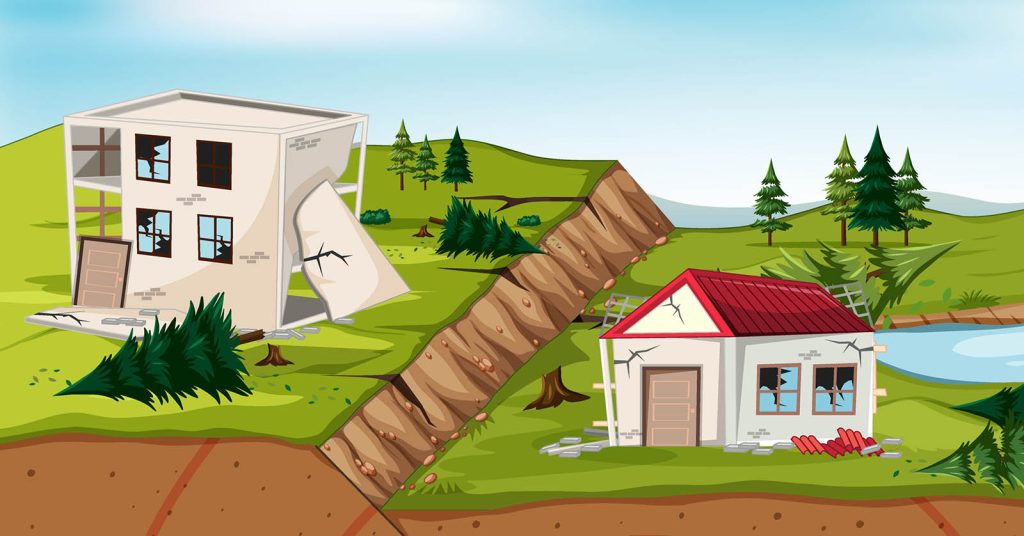Standard homeowners insurance usually excludes earthquake damage, so the only way to insure against major shaking is a separate earthquake policy. These policies work differently: percentage deductibles, coverage parts you must choose, and eligibility rules that can pause new sales after a quake. If you live near faults or in older, unretrofitted construction, the financial stakes are high enough that even a pricey policy can make sense. This guide clarifies who should consider coverage, how deductibles and options actually work, typical cost drivers, and the practical timing rules that catch many households off guard.
Key Takeaways
- Home policies don’t cover quakes — earthquake is a separate policy with percentage deductibles.
- Risk varies by map and build — hazard zones, soil, age, and retrofits drive price and availability.
- Plan for big deductibles — common ranges are ~5%–25% of your dwelling limit (location-dependent).
- Timing matters — many insurers pause new sales after quakes; buy before activity.
What earthquake insurance actually covers (and what it excludes)
Earthquake policies are built to cover direct physical loss caused by shaking. Core parts usually include: Dwelling/Building (structure and foundation), Personal Property (your belongings), and Loss of Use (temporary housing and extra living costs) when the policy offers it. In California, many homeowners buy through the California Earthquake Authority (CEA) via their regular home insurer; CEA offers multiple deductible choices and optional add-ons such as building-code upgrades, breakables, and emergency repairs. FEMA’s consumer pages and state regulator guides emphasize that earthquake is separate from homeowners and must be bought in advance of an event.
Deductibles are the big difference from homeowners claims. Instead of a flat amount, earthquake policies use a percentage deductible of your coverage limit — commonly 10%–20%, with options from about 5% up to 25% in higher-risk areas or certain home types. That means a $500,000 dwelling limit with a 15% deductible leaves you responsible for the first $75,000 of covered structural damage before the insurer pays. Consumer materials from the NAIC and the Insurance Information Institute use the same framing and examples so you can ballpark your exposure quickly. CEA’s current homeowner options list deductibles of 5%, 10%, 15%, 20%, or 25% (with restrictions for $1M+ homes and certain pre-1980 raised foundations without verified retrofit).
Coverage limits and options vary. Under CEA’s homeowner program today, Personal Property limits are generally available at $5,000 or $25,000 (policy-specific), while Loss of Use has no deductible and offers tiered limits up to $100,000. Policies also include small “Emergency Repairs” allowances that help you tarp, board up, or secure utilities right away. Private earthquake insurers (outside CEA) may offer higher personal-property limits or different combinations (including broader breakables coverage), but details are carrier-specific and underwriting-driven.
What’s not covered? Earth movement not caused by a quake (e.g., certain landslides), pre-existing damage, and maintenance-type repairs are typically excluded, and fragile items may require special options. As with any policy, the exclusions page controls; read it with your agent before you set limits and pick a deductible.
Who needs earthquake insurance (and how to judge your risk)
Start with seismic hazard maps and local building stock. The U.S. Geological Survey publishes national shaking-hazard maps that show where strong ground motion is most likely over long periods; high-hazard corridors run along the West Coast (California, Oregon, Washington) and parts of Alaska, but important pockets exist in the Intermountain West (Utah, Nevada), the central U.S. (Missouri’s New Madrid zone, Oklahoma), and the East (South Carolina, Puerto Rico). If your home sits on soft soils or near known faults, your expected shaking — and premium — rises.
Second, consider construction year and retrofit. Older homes (pre-modern seismic codes) and raised-foundation structures that haven’t been bolted/cripple-wall braced tend to price higher and, in California’s CEA program, may have fewer low-deductible options until retrofitted. Many carriers and state guides highlight discounts or eligibility improvements for verified retrofits. If you’re shopping, ask how a completed retrofit would change your quote and deductible options.
Third, look at financial exposure. If rebuilding would strain your savings, a policy protects against a rare but catastrophic loss. Renters and condo unit owners also face meaningful risk: quakes can destroy belongings and make a unit uninhabitable even if the building’s master policy covers structural damage. For HOAs, master earthquake decisions and high master deductibles can lead to loss assessments on unit owners; condo earthquake policies can add specific loss-assessment coverage.
Finally, timing: many insurers invoke a moratorium on new or expanded earthquake coverage immediately after significant seismic activity in a region. That pause can last days to weeks depending on aftershock risk. A few states note typical waiting periods (often quoted as 10–30 days on some products), but moratoriums are the more common gate — the takeaway is the same: buy before the ground moves.
What earthquake insurance costs (and why quotes vary so much)
There’s no single price because cost reflects hazard, home, and choices:
- Hazard & location — proximity to faults, soil, and local risk. Public hazard maps and state resources drive the baseline.
- Home factors — year built, foundation type, stories, roof/materials, replacement cost, and verified retrofit status.
- Policy choices — coverage limits (dwelling, personal property, loss of use), deductible (5% to 25%+), and options like code-upgrade or breakables.
For a directional sense, consumer outlets and state resources show wide ranges — from a few hundred dollars per year in lower-risk areas to a few thousand in high-hazard coastal zones. In California, the CEA publishes a premium calculator so you can see how your address, limit, and deductible move the price; recent program updates also note average rate adjustments by policy type. Private-market quotes can be above or below CEA depending on home and zip code. Always compare both, apples-to-apples on limits and deductibles.
Cash-flow note: like most property policies, earthquake insurance bills annually or in installments. If your budget is tight, increasing the deductible can materially lower premiums — but be honest about your ability to fund that out-of-pocket share after a loss.
| Policy piece | Typical details | What to watch |
|---|---|---|
| Dwelling/Building | Limit tied to your home’s replacement cost. | Deductible is a % of this limit (e.g., 10%–20%+). |
| Personal Property | Common limit options (e.g., $5k or $25k under CEA homeowners). | Fragile items may need optional “breakables” coverage. |
| Loss of Use | Temporary housing and added living costs; no deductible under CEA. | Pick a limit that reflects real local rents and family size. |
| Deductible | Often 5%–25% (higher risk → higher minimums). | Applies separately to structures/contents in some policies. |
| Timing | Sales can pause after quakes (moratoriums). | Buy early; changes may be blocked during aftershocks. |
Deductibles, moratoriums, and claims: key mechanics to know
Percentage deductibles. Unlike the flat deductibles on most home claims, earthquake deductibles are percentages of the insured limit. NAIC and III consumer explainers commonly cite ranges like 10%–20%, with higher-risk states often using ~10% minimums. In CEA’s homeowner program, you choose among 5%, 10%, 15%, 20%, 25% (subject to exceptions), and some coverages (like Loss of Use) have no deductible. Many modern policies also allow separate deductibles for personal property vs. the dwelling, which can help when belongings are heavily damaged but structural damage is modest.
Moratoriums after events. Earthquake policies generally don’t have a built-in “waiting period” once issued, but before you buy, insurers often impose a temporary suspension on new sales after a quake in the area. State insurance departments highlight this as a practical reason to secure coverage before seismic activity — you won’t be able to start or increase coverage during an active swarm.
Claims basics. After a damaging quake, prioritize safety and emergency repairs (turn off gas, secure hazards), then document damage thoroughly. CEA policies set aside a small Emergency Repairs amount you can use right away, and policy language outlines how deductibles apply and what receipts are needed. Keep photos, serial numbers, and contractor estimates together; expect multiple inspections for structural claims and code-upgrade determinations.
Private earthquake vs. CEA (and options for renters & condos)
CEA (California) is a not-for-profit mechanism selling through participating home insurers. It’s widely available and transparent on deductibles and options. Recent materials highlight loss-of-use limits up to $100,000 with no deductible, small emergency-repair benefits, and homeowner personal-property options commonly at $5,000 or $25,000. The CEA site also provides a public premium calculator and posts program updates (including annual rate adjustments and option changes).
Private insurers can compete with higher personal-property limits, different breakables coverage, or bundled ALE. Pricing can be better or worse than CEA depending on address and construction, and underwriting appetite changes over time. If you’re shopping in California, compare a CEA quote with at least one private-market quote; outside California, you’ll primarily evaluate private carriers using your state’s consumer guides.
Renters and condo owners should look at dedicated earthquake policies tailored to their situation. Renters insure belongings and loss of use (no building coverage). Condo owners can buy coverage for personal property, interior improvements, loss of use, and loss assessments that an HOA may pass down after a quake. Read your HOA’s master policy and deductible structure so your own limits match the likely assessment math.
Checklist: decide, set limits, and avoid common gaps
1) Check your hazard and code. Review USGS hazard maps and local code history. High hazard or older, unretrofitted construction argues strongly for coverage.
2) Price both markets. In California, pull a CEA estimate and a private quote; elsewhere, compare at least two private carriers. Use the same dwelling limit and vary deductibles to see the tradeoffs.
3) Right-size personal property & loss of use. Inventory major belongings and estimate local rents; pick limits that fit a realistic displacement period. Remember: some programs have low personal-property caps unless you add options.
4) Consider a retrofit. Seismic retrofits can protect life and structure — and may unlock lower deductibles or better pricing.
5) Buy early. Don’t wait for foreshocks. Moratoriums can block new coverage after a quake.
Frequently Asked Questions (FAQs)
Do I need earthquake insurance if I’m not on the West Coast?
Maybe. Forty-plus states have some earthquake hazard. Risk pockets exist in the central and eastern U.S. (e.g., New Madrid zone, parts of Oklahoma, South Carolina, Puerto Rico). Use USGS hazard maps and local history to judge your exposure and price a policy.
How big are the deductibles, really?
Common ranges are about 10%–20% of the insured limit, with options as low as 5% and as high as 25%+ depending on carrier and risk. In California’s CEA program, homeowners can choose 5%, 10%, 15%, 20%, or 25% (with restrictions for high-value or certain older raised-foundation homes). Loss of Use in CEA has no deductible.
Can I buy coverage right after an earthquake?
Usually not. Insurers often impose moratoriums after quakes, temporarily pausing new sales or changes. Secure coverage before seismic activity if you think you’ll want it.
What does a CEA homeowner policy typically offer?
Percentage deductibles, structural coverage to your dwelling limit, personal-property options commonly at $5,000 or $25,000, Loss of Use with no deductible and limits up to $100,000, emergency repairs, and optional add-ons (code upgrade, breakables). Exact options depend on the policy form and your home.
Are renters and condo owners covered by their landlord/HOA?
Not for your personal belongings or displacement costs. Renters need their own earthquake policy for contents and loss of use. Condo owners should add unit-owner earthquake coverage and consider loss-assessment protection to handle HOA deductibles after a quake.
Sources
- FEMA — Earthquake insurance overview (coverage basics)
- USGS — National earthquake shaking-hazard maps (risk context)
- NAIC — Earthquake insurance topic page (percentage deductibles)
- Insurance Information Institute — Deductible ranges & examples
- CEA — Homeowner coverages, deductible options, Loss of Use
- California Dept. of Insurance — CEA options, restrictions & Loss of Use
- CEA Agent Portal — 2025 rate/policy changes (program updates)
- CEA — Premium calculator (estimate your cost)
- Utah Insurance Dept. — Waiting periods & moratorium note
- FEMA — U.S. earthquake hazard maps (geographic variation)









